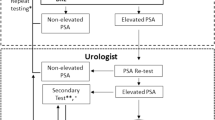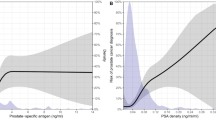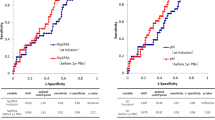Abstract
The purpose of this study was to determine the incidence of prostate cancer in patients who have an elevated referral prostate-specific antigen (PSA), which subsequently falls to within their normal age-specific reference range prior to prostate biopsy. The study demonstrated that of the 160 patients recruited, 21 (13%) had a repeat PSA level which had fallen back to within their normal range. Five of these 21 patients (24%) were diagnosed with prostate cancer following biopsy, two of whom had a benign prostate examination. The study, therefore, demonstrates that normalisation of the PSA level prior to biopsy does not exclude the presence of prostate cancer even when the prostate feels benign.
This is a preview of subscription content, access via your institution
Access options
Subscribe to this journal
Receive 4 print issues and online access
$259.00 per year
only $64.75 per issue
Buy this article
- Purchase on SpringerLink
- Instant access to full article PDF
Prices may be subject to local taxes which are calculated during checkout


Similar content being viewed by others
References
Stamey TA et al. Prostate-specific antigen as a serum marker for adenocarcinoma of the prostate. N Engl J Med 1987; 317: 909–916.
Eastham JA et al. Polyp prevention trial study group. JAMA 2003; 289: 2695–2700.
Singh RR et al. Repeating the measurement of prostate-specific antigen in symptomatic men can avoid unnecessary prostatic biopsy. Br J Urol Int 2004; 92: 932–935.
Boddy JL et al. Intra-individual variation of serum prostate specific antigen levels in men with benign prostate biopsies. Br J Urol Int 2004; 93: 735–738.
Lujan M et al. Prostate specific antigen variation in patients without clinically evident prostate cancer. J Urol 1999; 162: 1311–1313.
Thompson IM et al. Prevalence of prostate cancer among men with a prostate-specific antigen level <4.0 ng per millilitre. N Engl J Med 2004; 359: 2239–2246.
Stamey TA et al. Preoperative serum prostate specific antigen levels between 2 and 22 ng/ml correlate poorly with post-radical prostatectomy cancer morphology: Prostate specific antigen cure rates appear constant between 2 and 9 ng/ml. J Urol 2002; 167: 103–111.
Acknowledgements
We thank Miss Karen Wilmott for her help with data collection during this study.
Author information
Authors and Affiliations
Corresponding author
Additional information
No financial disclosures.
Rights and permissions
About this article
Cite this article
Boddy, J., Pike, D., Al-Hayek, S. et al. An elevated PSA, which normalizes, does not exclude the presence of prostate cancer. Prostate Cancer Prostatic Dis 8, 349–352 (2005). https://doi.org/10.1038/sj.pcan.4500819
Received:
Revised:
Accepted:
Published:
Issue date:
DOI: https://doi.org/10.1038/sj.pcan.4500819
Keywords
This article is cited by
-
Repeating an abnormal prostate-specific antigen (PSA) level: how relevant is a decrease in PSA?
Prostate Cancer and Prostatic Diseases (2009)



